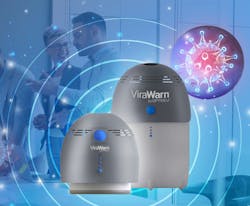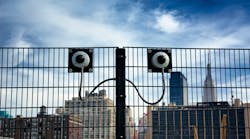This article first appeared in the August 2021 issue of Security Business magazine. When sharing, don’t forget to mention Security Business magazine on LinkedIn and @SecBusinessMag on Twitter.
As expert security technologist Steve Surfaro wrote in his June article, Securing the New Perimeter (www.securityinfowatch.com/21223503), the notion of a hard perimeter – with associated fencing and sensors – has evolved to include a softer perimeter, which includes concerns such as cybersecurity and air quality.
This concern over the new perimeter has led to several companies marrying the Internet of Things with devices for HVAC monitoring and air quality detection. As America returns to work and school, one of those companies, Opteev, has taken air quality detection a step further with its new ViraWarn system, designed to detect the presence of any spike protein virus including influenza, COVID-19 and variants.
“Air quality is something that I think everyone is increasingly becoming aware of – not just in the fact that now we know that most of the virus spread was through the air as opposed to on surfaces, but there is also increased concern about the quality of air in indoor spaces,” explains Conrad Bessemer, Opteev’s Chairman and co-founder. “This is mainly because many offices and classrooms have windows that do not open, so they are entirely dependent on the airflow circulating within the building.”
Opteev was formed by the combination of Novatec Inc., a company that originally provided air filtration equipment for use on submarines during World War II, and IoT specialist MachineSense LLC. Security integrators may have become familiar with the company when it introduced its FeverWarn FDA-compliant thermal scanner in early 2021.
ViraWarn is the next progression. The product, which will become available in September, plugs into the electrical sockets around the periphery of a room, or can be hardwired. The unit’s indoor air quality sensors quickly detect airborne viruses within minutes of their introduction by infected individuals. They suck in surrounding air for analysis. If a viral alert is triggered, a visual indication via an LED light and an audible buzzer signal immediately so that the room can be evacuated, disinfected and the occupants can be screened.
“Normally, when we are dealing with viruses, they are being breathed out, then they circulate around the room, and they fall to the floor. That is why we designed this product to be as close to the floor as possible, because that is eventually where the viruses wind up,” Bessemer explains.
The units capture airborne viruses within 10-12 feet of an infected person and use an onboard edge processor featuring advanced AI technology to detect and screen out false positives. The device reports all incidents through a connected app to help improve air quality. It can be a standalone system, although Bessemer says the company’s programmers can work with security integrators to incorporate the IoT devices into existing alarm system infrastructure as well.
All models include room temperature, relative humidity, proximity sensors (to detect human presence for auto-start operating modes). Certain models also feature air quality and carbon dioxide modeling.
While the ViraWarn system may have been spurred by COVID safety, air quality sensors and related technologies have been steadily emerging as a new area of perimeter security monitoring. “As a result of the pandemic, people are starting to recognize that air quality is something you really have to think about,” Bessemer says. “I expect sometime in the next five years, the U.S. will mandate what air quality needs to be in classrooms and public spaces, for example.”
Learn more about the product at http://opteev.com/virawarn-indoor-air-quality-testing.
Paul Rothman is Editor-in-Chief of Security Business magazine. Email him your comments and questions at [email protected]. Access the current issue, full archives and apply for a free subscription at www.securitybusinessmag.com.




